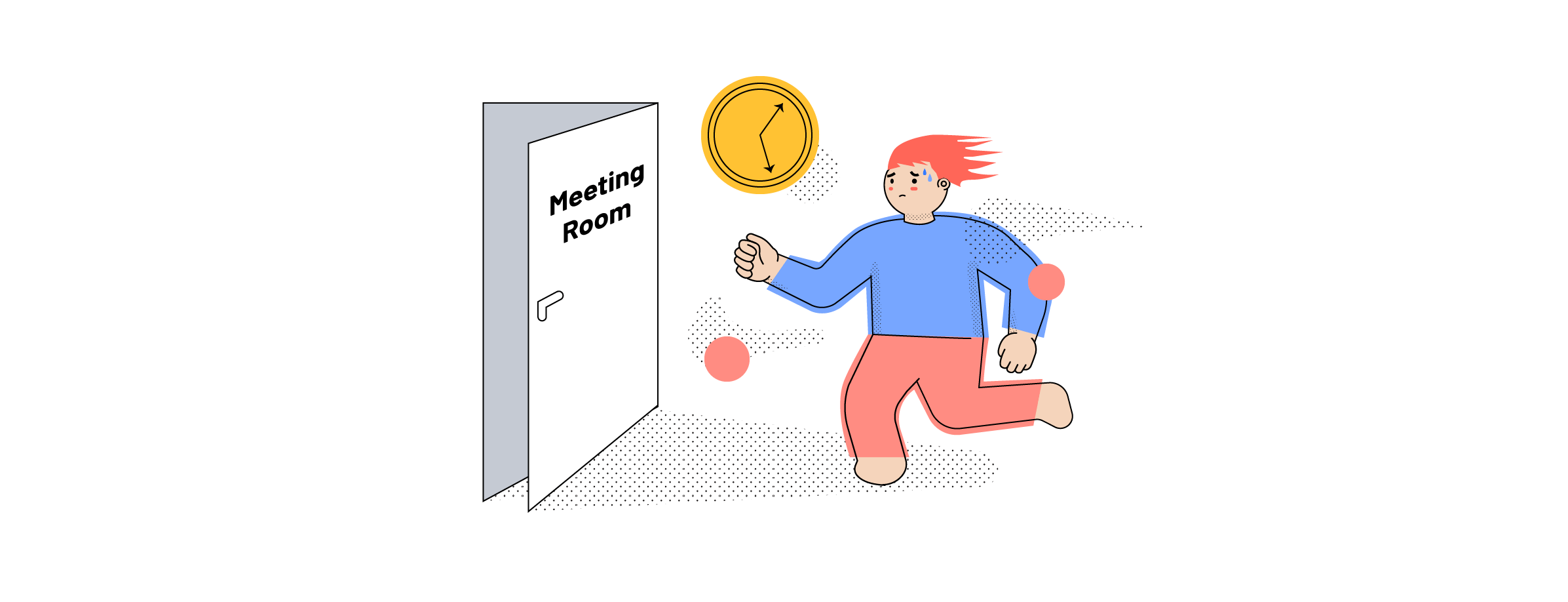Ensure your business meetings run smoothly by following these business meeting guidelines and useful tips on how to hold effective meetings
The 50 golden rules for good business meeting etiquette

We’ve all experienced a ‘bad’ business meeting. They come in many shapes and forms. There are those where attendees show up 15 minutes late, those with an unclear purpose, and again there are those you don’t even feel you need.
If you’re a middle manager, you spend around 35% of your time in meetings. Upper management uses a staggering 50%. Why is that? Could it be that we’re trying to multitask – doing too many things at once – when in fact we’re not being productive at all? Or are we scheduling meetings simply out of habit?
Whatever the reason, it’s a lot of time is spend trying to bounce ideas, solve problems, and in the end get something done. All those meetings require a successful strategy. That’s why we’ve put together a list of must-know rules on how to run an efficient business meeting, both for meeting leaders and participants.
These tips aren’t universally applicable for all meetings. Some should only be reserved for the most formal. Instead, we hope the reader will look at this as a miscellaneous collection – and where the reader is free to pick and choose what could be relevant to their own environment.
Before a business meeting
What’s the most important thing to consider before a meeting? Come prepared. Not just you, the organizer, but the attendees as well. The benefits are enormous when you work smart and prep ahead.
1. Do you really need this business meeting?
Not everything can or should be resolved in a meeting. Perhaps you don’t even need to schedule it! That’s why the first and most important rule is to have a specific purpose before scheduling a meeting. If you don’t have a purpose, don’t schedule a meeting. Can the matter be resolved via email or quick chat instead? Then do so instead.
2. Only invite necessary people
Include only the people who are relevant to the discussion or have a say in the matter. Inviting too many people who are not directly involved isn’t just wasting their time, it’s wasting everyone else’s as well. Besides that, if you overcrowd the meeting room, you won’t get as much done.
Amazon’s Jeff Bezos argues that you should never have a business meeting where two pizzas couldn’t feed the entire group, the idea being that the more people in a meeting, the less productive you’ll end up being.
It used to be that a profession dictated your persona, meaning that doctors act a certain way that’s different than accountants or graphic designers. But we all communicate in different ways, just as we learn and engage in different ways too. If you understand your crowd, then you know how to keep them engaged as well.

3. Choose the right time
Organizing around multiple time zones or even just a bigger office space can be daunting. Ultimately, it’s hard to please everyone. Try to be conscientious of the fact that, if you’re organizing a transatlantic meeting, some people are just starting for the day, with the other wrapping up.
This affects the time of the meeting, but also the energy in the respective rooms, and the engagement with whoever is presenting. It’s not something you can change, but it’s something you should be mindful of and acknowledge.
4. Choose the right meeting room
Choose the meeting room applicable for the amount of people, supplies, and type of meeting you’re having. The same room doesn’t work for both brainstorming session, sprints, and 1:1s. It’s crucial to get the right environment.
Not only does the room have to fit the session you’re about to have, it needs to meet the requirements for the right type of equipment too. Think about device compatibility, screens, lighting. And don’t roam the hallways ten minutes before to make sure there’s a room available.
What room is the right room? Check out our rundown of the most essential office rooms, including the office pod, huddle room and the conference room.

5. Send an official invite
You can’t expect people to show up on time if there is no set date and time booked in their calendar. Make sure to send an official invite in advance via your preferred calendar service, so the people attending can reserve their time.
6. How much time do you need?
Have you ever been in a business meeting that lasted way longer than was necessary? Yes, us too. A lot of meetings are scheduled for a full hour, some even two, when they should only be half that time or less.
Just as you shouldn’t invite a whole list of unnecessary people, the meeting shouldn’t go on for longer than what’s needed. Ultimately, using more time than you need kills productivity and makes people lose focus.
The standard one-hour business meeting often happens because it’s easy to schedule in calendars, and, perhaps, because it’s what we’ve always done. Meetings can be shorter and longer, depending on the purpose and goals. Ask yourself before any meeting whether you need it at all, and if, how much time to set aside.

7. Incorporate minutes/round-up of the previous business meeting in the invite
Is this a recurring meeting? Then chances are you’re following up on something from the last round. Include what was discussed in the last meeting and also any accomplishments done in the meantime.
8. Outline what attendees need to bring
Must-haves to bring to a meeting include note-taking gear, such as a notepad and pen or laptop. Both can come in handy, we find. These days, it’s usually always alright to bring a laptop for taking notes, but it depends on where you’re going.
Having laptops in the business meeting environment breeds procrastination and in some cases even disrespectful meeting conduct, so be mindful of that when scheduling and recommending people to bring them. We couldn’t live without ours, just like some businesses never go anywhere without a stack of business cards. But even we like to keep the laptops out of the equation every once in a while.
9. Have an agenda
Detailing what the meeting will cover will help you and the other attendees stay on topic for the duration of the meeting. Keep the agenda simple and send it out several days in advance for people to get a chance to look it over.

10. Set success criteria and calibrate expectations
Increase business meeting effectiveness with success criteria – yes. Set goals and meet them – yes. Reflect on your progress and improve – yes, please!
It begins when you organize the meeting. Why are you meeting? What’s the objective? What do you hope to accomplish? When you send out the invite, include the overall objective. The social pressure will help you all focus on obtaining your goals and commit to not wasting too much time. It might be concealed expectations and not something you have to present to the whole attendee list.
Start the business meeting with a reminder of what success looks like for the meeting and what you hope to gain from the gathering. Afterwards, it’s easier to analyze on the progress you’ve made and where you can improve.
You shouldn’t only be looking at success criteria though, but also know how to calibrate expectations for you and your team.
One thing every manager has experienced is lack of engagement of the attendees. Even though they put a lot of time and effort into organizing the meeting, it’s impossible to account for. You have to learn the hard way that your level of commitment to the meeting might not be reciprocated. It’s a harsh reality, but you as organizer can’t be disheartened if you feel that a business meeting didn’t go as smoothly as you expected.
In the end, this is a task in getting to know your workforce better, and catering your approach to fit their expectations. Yeah, it’s a thankless task, but a necessary one.
11. Be prepared
Are your slides in order, your software up to date? Practice and revise your presentation to fit your audience and make sure everything is in order technically beforehand.
If you’re presenting in the meeting, but not hosting, and need extra aids such as a pointer, certain projector or audio, make sure the meeting environment you’ll be at has the necessary equipment ready. It’s easier to use something from the native environment rather than bringing your own, although sometimes you want to bring extras anyway.
12. Provide copies of essential documents
Send important documents prior to the business meetings instead of handing them out as the meeting starts. It creates less of a distraction if the items have already been sent out for reference. And yes, it’s useless if you send important documents 20 minutes before the meeting starts.
13. Check equipment
Make sure all attendees have access to the program you attend to use if the business meeting will be held online. Let them know in advance if they need to install an app or program for the meeting to go smoothly.
A wireless presenting solution such as Airtame helps relieve some of the stress in the situation – all attendees have to do is download the app and they are good to start presenting wirelessly.

14. Confirm the business meeting
If you’ve scheduled the meeting some time in advance, follow up with participants a day ahead to let them know that the meeting is coming up. Especially visitors will appreciate the reminder.
When confirming the meeting, you also have the chance to share new info or documents that pertain to the set agenda, and that’s often valuable at this point.
Of course, this is only relevant for some business meetings, in particular ones that are large and planned way out in advance.
15. Cancel if you have a conflict
Unless it’s an emergency, there’s no excuse for canceling a meeting minutes before it begins. Plan ahead and call in advance if you see a conflict arises.
16. Rehearse your presentation
“Sorry, I just kinda threw it together last minute,” isn’t an excuse you should ever make. Don’t assume you can wing a presentation on the spot. There’s no good answer to how many times you should rehearse because it depends on you, the venue, the audience, the attendees, basically the whole shebang.
If you’re doing a TED talk rather than a chit-chat with your co-worker, that obviously calls for a bit more practice. That being said, it’s never out of place to look over your slides a few times, correct whatever errors might still be in there, and go over what you want to say.
Additionally, rehearsing your presentation or the points of an agenda can help solidify your good arguments and cut the bad ones.
17. Consider all technical efforts ahead of time
Mostly, this comes down to preparation on the meeting leader’s behalf. Don’t assume you have enough battery on your laptop or phone to go through the meeting, don’t assume a video will load, don’t assume everything is in place … Check your setup and test it before showtime.
During a business meeting
Business meeting attendees could be calling in from the same office or from anywhere else in the world. It’s your job, as the organizer, to make sure everyone feels welcome. Use technologies that improve the visual experience and team collaboration and work on your presentation skills.
18. Don’t be late
Show up on time. There’s no excuse for being late for a business meeting, no matter what your role in it is. If you are, a simple apology to the organizer and the rest of the attendees is always appreciated, just don’t make a big fuss of it.
Even if you usually tend to arrive late for personal appointments, make an effort of always arriving a little bit early for business meetings.
Besides providing extra breathing room before an important meeting, you’ll probably be perceived as more orderly since you don’t cause unnecessary disruption.
We all have different personality types, and while being late for personal arrangements isn’t a problem in your surroundings, arriving on time is generally perceived as mandatory in professional settings.

19. Assign a leader
Someone is in charge of the business meeting, and it’s most likely the person who organized it, excluding PAs and the like. Every business meeting needs a leader, someone who knows they’re in charge of running it. Meeting leaders are key to successful meetings and make sure that actions are taken before, during and after.
The meeting leader is responsible for organizing, planning, and carrying out the meeting. That includes sending out invites, checking up on attendees, booking a room, testing equipment, ensuring that the meeting progresses in an orderly fashion and reaches its goals.
20. Assign a note-taker
While the meeting leader is in charge of communication, the agenda, even icebreaking, they might not be the right person to do the minutes as well.
Because the meeting leader is frequently speaking or being extra attentive to other attendees, it can be a good idea to assign a note-taker. The meeting leader can then sum up the notes after the meeting and send out a summary.
It can also be valuable to video or simply audio record the meeting, to make more detailed minutes later. If you’re doing this, please ask and notify the rest of the attendees ahead of time.
21. Look professional
Looking confident encourages acting confident. You shouldn’t feel like you have to dress up for a meeting, but there is a difference between meeting with colleagues and out-of-office clients.
As a general thumb rule for presenters, try not to draw attention to one specific detail in your outfit via graphic prints or colors, like popping nail color or t-shirt slogans, but instead make the overall image that of a neutral, blended, and put together individual.
22. Wait for everyone to arrive
You’re on time, but your colleagues aren’t. Do you dive in? No. Give them a couple of minutes more and wait until everyone has arrived or dialed in before you start with anything else than introductions.
That said, though, don’t wait forever for late-comers. Just like you should be on time, they should too, and you don’t have to encourage impoliteness.
23. Know where to sit
This might seem like an oddity to mention, but the seating position in a meeting room actually says something about people’s perception of you, your relationship with others in the room, and what you want to convey in the situation of the meeting. Not all seats are created equal, so choose wisely when picking a chair.
Are you a Power Player, Ally, Contender or Sideliner? Research shows you should use your boss as a compass in a meeting – if you want to be heard, sit close to them. If you want to go unnoticed, sit far away from them, but not opposite.

24. Make introductions
Welcome all attendees as they show up either in person or online. If it’s a business meeting with externals or new members of the team, be sure to take a turn around the room for everyone to introduce themselves and their role so they can all become acquainted.
25. Be polite with your smart devices
It’s not always necessary to turn your mobile device completely off but if you’re in doubt whether or not it’s appropriate (it almost never is), turn it off just to be sure. Or put in on silent, flight mode or anything non-disturbing that won’t suddenly flare up in a flash of sound and noise. Even better – don’t bring it into the business meeting at all.
The same goes for laptops. Are laptops approved devices for taking notes? Do you need it for presenting? If not, close it or stow it away entirely. If you start using your phone or laptop to check emails or other irrelevant stuff, other people will likely follow suit.
26. Limit clutter on your slides
Why is this important? The answer is that anyone can read something without the need for a meeting. Make sure your presentation offers new insights that can be digested at a glance.
With less clutter, attendees will focus on you, the presenter, instead of the slideshow. Secondly, it’s easier on the eyes. Leave a decent amount of white space instead of cluttering your slides with extraneous words, numbers or images.
If you don’t overcrowd your slides, you’ll be able to grab the attention of attendees much better. There’s a small test you can try to make sure people will comprehend your slides. Will they get what’s happening by glancing at your slide for just 3 seconds?
Duarte Design uses a clever analogy: Your slides are like billboards, while you, the presenter, are the main road, the main focus. Just like a driver shouldn’t take their eyes off the road for too long a time, the audience’s main focus should lie with you.

27. Don’t interrupt
Even business meeting situations can create an excitable or animated environment, with passionate discussions and heated debate. Keep your cool and let others finish talking before speaking yourself. If you have trouble remembering your thoughts, write down notes – as long as it doesn’t distract you from listening.
28. Be mindful of different personalities
Not everyone thrives in business meeting environments, which is a big challenge for managers in charge of a mixed team. There are the outgoing, gregarious folk that love open discussions and presenting, versus those perhaps more meditative in thought, precise and reserved.
The latter can end up switching off in meetings, or feeling uncomfortable having their opinions raised. In these scenarios, it’s good to consider how much pre-work can be expected in a business meeting. This is likely to be where the more introverted colleague can shine.
As we outlined in rule 2, not everyone needs to be included in all meetings. We like to think of the dinner party analogy: you need to find the right mix of people that play well off each other.
29. Listen!
Listening to what others say is crucial to any business meeting situation. But not only that, showing that you listen can make a difference too. Adjust your body language to show enthusiasm, even if you’re participating via video chat.
Research shows that being a good listener can even make you a better leader, as indicated by The New York Times.
Trying to multitask in a business meeting tells your colleagues that they’re not as important as whatever you’re doing and it’s contagious. Focus, listen attentively and see if your topic isn’t covered sometime during the meeting.
30. Don’t dominate discussions
You’re clever, you’re smart, you have something brilliant to say. But as with interruptions, dominating the business meeting isn’t a welcome approach unless you’re the meeting leader and it serves a specific purpose.
To control who can speak at any given time, some even use a physical aid like a ball. Hopefully, that’s only required for the most unruly of candidates.
31. Don’t procrastinate
Right, so we all procrastinate from time to time, and that’s okay. In business meetings, not so much. It’s up to the organizer to make sure the meeting is well thought out, not too long and has a clear purpose. It’s easy for attendees to drift or want to focus on other items if things feel scrambled.
Don’t get easily distracted when discussions stray off-topic, help others stay focused, and adjust your body language. These points will all help put an end to procrastination.

32. Make eye contact
Don’t be awkward: eye contact is a crucial factor in any good meeting. It’s a powerful way to engage others, either by inviting them into the conversation, letting them know they’re next in line to talk or gesture to someone that they should participate in the conversation.
Give it a try and see if you can’t manage the room a little better just by using those baby blues.
33. Follow good online conference etiquette
If you’re in an online conference call, you should make sure your profile picture and username are both appropriate. Test volume levels right away and mute when not speaking.
If you’re sharing your screen, close all other irrelevant programs and tabs on your computer. Airtame has just released Single Window Sharing, a feature that allows you to share only one window of your choosing while all other windows stay hidden.
34. Stay on topic
If you stray off topic from time to time – it happens in most business meetings – try to lead the conversation back to the main purpose. If the topic of conversation drifts for too long, everyone should be responsible for raising a hand, flagging it down, and bringing the topic back to the center.
It’s not only acceptable but necessary to let the other attendees know if the conversation has gone rogue.
35. To humor or not to humor?
Using humor is tricky and not always well-received. In a setting with closer teammates, it can be relatable and even help release tension, whereas it can cause unnecessary tension if used towards clients or people you don’t know well.
If you decide to go down the joking road, make sure it’s appropriate enough to suit your audience, no matter how well you know them. Dad jokes and puns can be quirky and fun, but sometimes it’s better to tone it down just a notch so as not to step on anyone’s toes.

36. Know your audience
There are several relevant points to make adherent to the audience. First of all, use a tone that is appropriate. Think about age, demographics, background, etc. Secondly, choose a topic that is relevant. People are not likely to listen to you if you’re not catering your message to them.
In other settings however, you also have to consider cultural boundaries. Things such as hierarchy, hand gestures, speaking out of turn, even the length of the meeting can all be connected to a specific cultural setting – and possibly not anything like what you’re used to.
Punctuality is essential in several Asian countries, and so is a hierarchical establishment of the business meeting’s participants. Gifts are common courtesy, and sometimes drinking is even part of the meeting as well.
37. Follow time constraints
Rule 5 was a big one: when you’ve booked the right timeframe, be sure to stick to it. Follow the timeline you set up for the meeting and end the meeting on time. Don’t simply run overtime. It is at the very least unprofessional, demotivating, and can have a knock-on effect on any meeting that follows.
Instead, show some humility and publicly acknowledge that you tried to cram too much into the one meeting, and that a follow-up will be scheduled.
38. Stay calm
It’s natural to be nervous in a business meeting, but try to make an effort to keep your cool. Staying calm and presentable – i.e. how you carry yourself – is very important and can help lead the way for clear content and communications thereof.
39. Talk confidently
See point 28 – not everyone is a natural in a business meeting setting, and that’s okay. Even the shyest people will find that talking confidently can convince themselves and the audience they’re talking to. In fact, public speaking can even provide quite a rush because the adrenaline is pumping and you’re pushing yourself.
Have you heard the latin phrase “errare humanum est”? It means that it’s human to err, and it’s more than fitting for public speaking. Mistakes are alright, you can even throw in a little light humor, if that’s your style, to help ease you into it.
When you do speak, don’t rush. If anything, speak so slowly it feels unnatural to you. We promise you, it sounds just fine.
40. Stay present
Your body language isn’t just important for active listening. You’re always able to tell if people want to be in the room or if they’d rather be somewhere else. Not every business meeting is a party, but it would be offensive to show that you’re bored and feel like your time is wasted.
Likewise, you’re also able to tell from the body language of other meeting participants how they feel. That can often be a good hint as to how the meeting’s going.
41. Help others stay present
Whether you’re the meeting organizer or a participant, don’t be afraid to call out others present that you feel are disengaged, talking, or in any way distracting the flow. Even the most ineffective of meeting presenters deserves the respect of active engagement from their audience.
42. Give space to different types of workers
More and more companies are choosing to board the remote train, encouraging a global focus in the workplace, and people working from all over the world. But those working remotely in coffee shops or secondary office spaces can quickly feel sidelined and disengaged if you don’t flesh out a functional remote infrastructure.
Include remote workers or those in secondary office locations as often as possible to ensure visibility into each other’s activities. They are as much part of the team as you are, and keeping them in the loop will help you all stay focused.
Perhaps even allocate more time to these people than those in the primary setting to make sure they feel welcome and heard.

43. Schedule time for breaks
During lengthy business meetings of more than an hour, schedule time for breaks and let people know about them as part of the agenda. This will help them stay focused. It also demonstrates a degree of empathy, highlighting that you know a toilet break, coffee run or quick clearing of the air is important to keep the energy up.
44. Move around
Meeting room arrangements don’t have to be old-school, boardroom style seating. No seriously, it’s not all knights of the round table and nothing else. Different kinds of rooms heavy on technology and dynamic presentations are taking over, fostering collaboration and freedom to share ideas.
Use Airtame and a pointer so you aren’t tethered to the front of the room. The freedom to room helps you establish more presence and engage better with your colleagues.

45. Leave time for questions
It’s an essential closing for every business meeting – and an amazing way for you to both clarify any discrepancies and improve for next time. You’ll probably find that having a dedicated time slot for questions at the end is more productive than people constantly raising their hand and interrupting during the meeting.
If the crowd has so many well-thought-out questions that there’s not enough time to bring up all the points at the allotted time for questions, ask if people would like to stay and finish the discussion. But give everyone the opportunity to leave on time before making assumptions.
After a business meeting
Business meetings are more often part of a larger project or strategy. Stop thinking of them as events that have a definite beginning and end. Keep yourself and your files in order to make sure you’re always ready to pick up where you left off.
46. Thank everyone for attending
If you called the business meeting, make sure to thank everyone for attending. It makes a difference and doesn’t cost you anything.

47. Follow up with notes/minutes
Share notes and reminders after the business meeting. If no notes were taken, thank everyone for attending by sending a quick email where you let them know you appreciated their time.
48. Follow up on action items
Action items should be sent around after the business meeting as a reminder of its focal points. Don’t forget to assign someone responsible for them because they’re useless without. Set deadlines as well as soon as possible.
If you promised to deliver on something promptly after the meeting, follow up immediately afterward.
49. Ask for – and give – feedback
All of us have likely tried a form of the feedback sandwich – with more or less luck. But besides criticism disguised as a compliment, there are other, arguably better ways to deliver constructive criticism. It’s imperative in a working environment to master the skill of giving feedback, both positive and negative, and you’d be surprised at how many actually want it.
In fact, studies show that employees crave feedback. Learn to comment constructively on the meeting itself, and the presenter. This feedback can, of course, be submitted in person, but there are also some great feedback apps like Duuoo that allow for anonymous communication.

50. Assess and adjust
Following up on the first item in this post, consider if you need the meetings at all. Not all recurring business meetings are productive, and you shouldn’t schedule meetings just for the sake of meetings.
Can something be changed to make your meetings more successful? Try to change things up every once in a while and see if you can make them even better.
No more passive business meetings with Airtame
Having Airtame in meeting rooms gives everyone the ability to present and easily connect. It allows for more freedom and a dynamic setting where opinions and ideas flow more freely. Since it’s a bring-your-own-device kind of solution, you’re not risking alienating anyone either.
Our mission is to go from passive business meetings with short attention spans to meeting settings where everyone can present easily and without disrupting the whole session.
While something like proper business meeting etiquette is indispensable to a successful meeting setting, we also believe Airtame can help alleviate some of the strain often experienced in those situations.